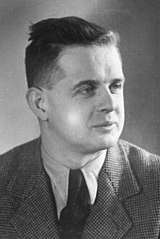Treblinka trials
The two Treblinka trials concerning the Treblinka extermination camp personnel began in 1964. Held at Düsseldorf in West Germany, they were the two judicial trials in a series of similar war crime trials held during the early 1960s, such as the Jerusalem Adolf Eichmann trial (1961) and the Frankfurt Auschwitz Trials (1963–65), as a result of which the general public came to realize the extent of the crimes that some two decades earlier had been perpetrated in occupied Poland by Nazi bureaucrats and their willing executioners. In the subsequent years, separate trials dealt with personnel of the Bełżec (1963–65), Sobibor (1966), and Majdanek (1975–81) extermination camps.[1]
 Düsseldorf District Court (Land- und Amtsgericht Düsseldorf). Trial location, 2008 photo. | |
Hirtreiter trial
In 1946 Josef Hirtreiter was arrested in the course of the Allied investigations into the killing of disabled persons in the Hadamar Euthanasia Centre. Although not focused on Treblinka from the beginning, and not serving as an upbeat to the later Treblinka trials, the Hirtreiter trial is viewed by some historians as being part of these.[2] Hirtreiter could not be shown to have been criminally involved at Hadamar; however, he did confess to having worked in a camp near the Polish village of Małkinia where Jews were killed in a gas chamber. Further investigations showed that Hirtreiter had been stationed at the Treblinka extermination camp, where he supervised the victims' disrobement prior to their gassing. He was charged with participation in the mass-murder of Jews, particularly the killing of more than 10 persons, including infants. On 3 March 1951 Hirtreiter was sentenced to life imprisonment (released in 1971).[3][4]
First Treblinka trial
The crimes committed in the General Government territory of occupied Poland were investigated by the Central Agency from July 1959 by the German specialist in the Nazi prosecution Dietrich Zeug, present at the Eichmann trial. His inquiry led to the first arrest of Treblinka deputy commandant on 2 December 1959. Zeug received survivor testimonies from Yad Vashem which allowed him to examine German national archives for more clues. He was the first to establish the chain of command for Operation Reinhard.[5]
The first Treblinka trial began on 12 October 1964 and concerned eleven members of the SS camp personnel, or about a quarter of the total number of SS employed in the extermination of Jews brought aboard Holocaust trains to Treblinka. More than 100 witnesses were called, with incriminating evidence presented by Franciszek Ząbecki, a dispatcher employed by the Reichsbahn during the Holocaust train departures from across occupied Poland, proven by original German waybills he collected. The verdicts were pronounced on 3 September 1965:[6]
| Defendants | Photograph | Rank | Function | Sentence | Reality |
|---|---|---|---|---|---|
| Kurt Franz | SS-Untersturmführer | Deputy commandant | Life imprisonment | Served 28 years, released, lived another 5 years | |
| Otto Richard Horn | SS-Unterscharführer | Totenlager – Corpse detail | Acquitted | ||
| Erwin Lambert |  |
SS-Unterscharführer | Built Large Gas Chambers | 4 years imprisonment | Time served. Died 1976 |
| Heinrich Matthes |  |
SS-Scharführer | Chief of Totenlager | Life imprisonment | |
| Willi Mentz |  |
SS-Unterscharführer | Lazarett ("Infirmary," which actually meant shooting victims) | Life imprisonment | Released in 1978 and died 3 months later |
| August Miete |  |
SS-Unterscharführer | Lazarett – "Angel of Death" | Life imprisonment | Possibly released in the mid 1980s.[7] |
| Gustav Münzberger | SS-Unterscharführer | Totenlager – Gas Chambers | 12 years imprisonment | Served 6 years, released on good behaviour, lived another 6 years | |
| Albert Rum | SS-Unterscharführer | Totenlager – Gas Chambers | 3 years imprisonment | ||
| Otto Stadie | SS-Stabsscharführer | Camp Administration | 6 years imprisonment | Released early due to poor health, lived about another decade | |
| Franz Suchomel |  |
SS-Unterscharführer | Gold and Valuables | 7 years imprisonment | Served 4 years, released, lived another 10 years |
| Kurt Küttner |  |
SS-Oberscharführer | Lower camp of Treblinka II | Died before trial |
Second Treblinka trial
The second Treblinka trial also known as the Stangl trial,[1] was held from 13 May to 22 December 1970, five years after the first group trial for war crimes. In this trial, camp commandant Franz Stangl, expelled three years earlier from Brazil, finally stood accused. Stangl had previously assisted in killing handicapped people during Operation T4 (the Euthanasia Programme of the National Socialists), and, before moving on to Treblinka, had been the first commandant of Sobibor. Under his supervision, most of the Treblinka killings took place. He was sentenced to life imprisonment, and died in prison on 28 June 1971, during the appeal case.
See also
- Belsen trial in 1945 of the SS functionaries from Auschwitz and Bergen-Belsen
- Belzec trial in the mid-1960s of eight former SS members of Belzec extermination camp
- Chełmno trials of the Chełmno extermination camp personnel, held in Poland and in Germany. The cases were decided almost twenty years apart
- Dachau trials held within the walls of the former Dachau concentration camp, 1945–1948
- Euthanasia trials, an overview of trials dealing specifically with the associated Nazi euthanasia programme
- Majdanek trials, the longest Nazi war crimes trial in history, spanning over 30 years
- Mauthausen-Gusen camp trials
- Nuremberg trials of the 23 most important leaders of the Third Reich, 1945–1946
- Ravensbrück Trial
- Sobibor trial held in Hagen, Germany in 1965 against the SS-men of the Sobibor extermination camp
- Ivan the Terrible (Treblinka guard), notorious Treblinka guard not brought to trial. In the 1970s-80s John Demjanjuk was accused of being Ivan and brought to trial in 1986, but eventually it was established that he was not the same person.
Notes
- Sereny, Gitta (1974). Into That Darkness: from Mercy Killing to Mass Murder, a study of Franz Stangl, the commandant of Treblinka.
- Bauer (1968), vol. 8; Hofmann.
- Bryant, Michael (2014). Eyewitness to Genocide: The Operation Reinhard Death Camp Trials, 1955-1966. Univ. of Tennessee Press. p. 36. ISBN 1621900495.
- Webb, Chris (2014). The Treblinka Death Camp: History, Biographies, Remembrance. Columbia University Press. pp. 195–196, 233. ISBN 3838265467.
- Ruth Bettina Birn. "Fifty Years After: A Critical Look At The Eichmann Trial" (PDF). Journal of International Law, Case Western Reserve University School of Law, Ohio (1/28/2012): 6, 13–14/31. PDF file, direct download. Archived from the original (PDF) on 2013-12-03.
- S.J. (2007), First Treblinka Trial H.E.A.R.T Holocaust Education & Archive Research Team.
- Hans Peter Rullmann, Der Fall Demjanjuk: Unschuldiger oder Massenmörder? Verlag Helmut Wild, 1987; p. 166. (in German)
References
- Bauer, Fritz, ed. (1968). Justiz und NS-Verbrechen: Sammlung deutscher Strafurteile wegen nationalsozialistischer Tötungsverbrechen 1945–1999 (Justice and Nazi Crimes: a Collection of German Verdicts on national socialist Killings) (in German). Amsterdam: Amsterdam University Press. ISBN 90-6042-000-4.CS1 maint: ref=harv (link)
- Erster Treblinka-Prozess (First Treblinka Trial): vol. 8, ISBN 90-6042-008-X.
- Zweiter Treblinka-Prozess (Second Treblinka Trial): vol. 22, ISBN 90-6042-022-5.
- Dritter Treblinka-Prozess (Third Treblinka Trial): vol. 34, ISBN 90-5356-720-8.
- Hofmann, Christian. "Die Treblinka-Prozesse (The Treblinka Trials)". shoa.de (in German). Arbeitskreis Shoa.de e.V.CS1 maint: ref=harv (link)
- Rückerl, Adalbert, ed. (1977). NS-Vernichtungslager im Spiegel deutscher Strafprozesse (Nazi Extermination Camps mirrored by German Criminal Trials). Munich. p. 81.CS1 maint: ref=harv (link)